5 Steps to Merge AI with Cottage Garden Design
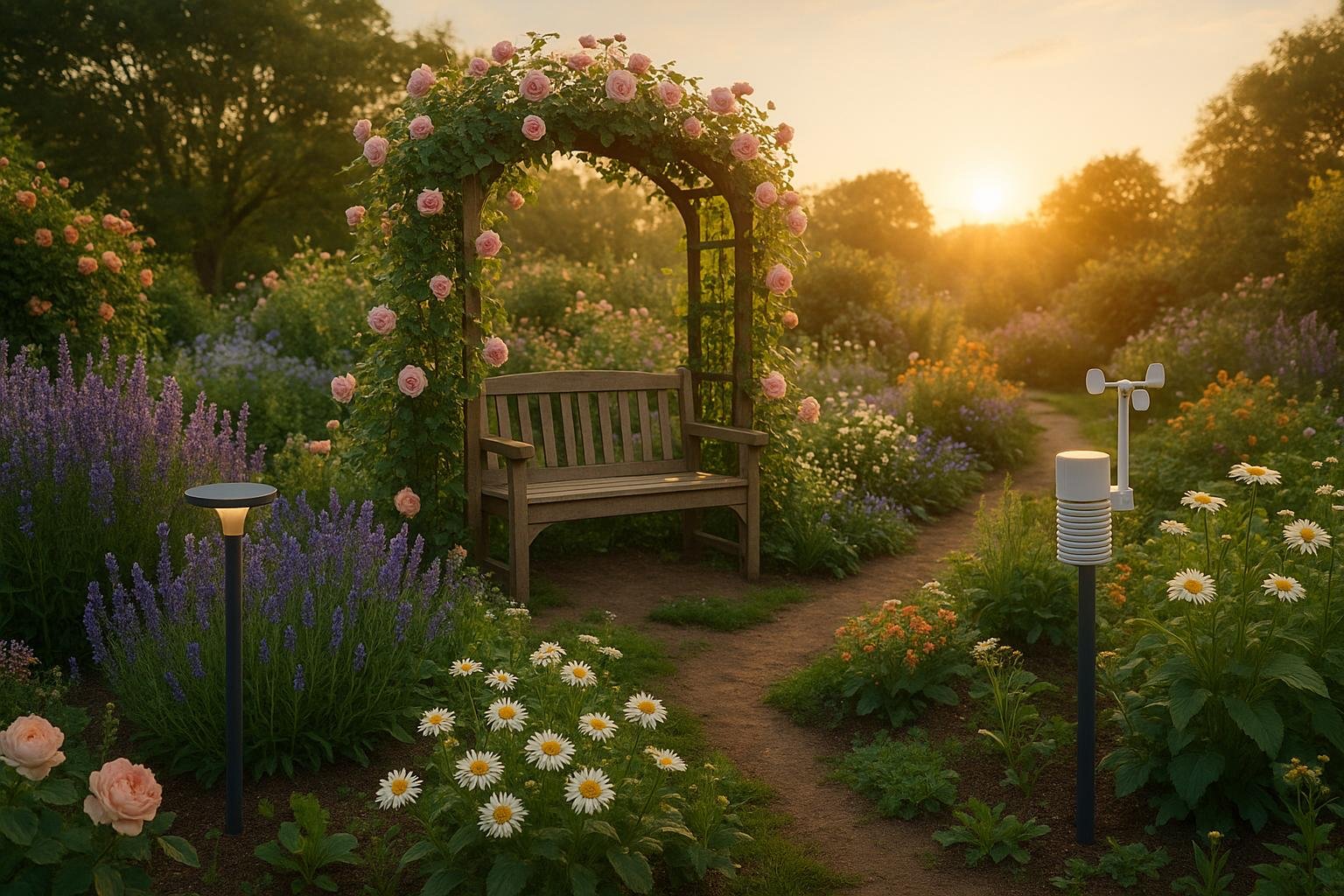
AI can make designing a cottage garden faster and easier. Here’s how:
- Learn the Basics: Understand the informal, flowing layout, classic plants (like foxgloves and lavender), and mix of flowers, herbs, and vegetables that define cottage gardens.
- Document Your Garden with AI: Take clear photos and let AI analyze your garden’s soil, sunlight, and climate for tailored recommendations.
- Design with AI Tools: Use platforms like AIGardenPlanner to create realistic layouts, choose templates, and customize your garden design in minutes.
- Refine AI Suggestions: Adjust plant arrangements, add pathways, and incorporate seasonal blooms for a natural look.
- Bring the Design to Life: Build your garden in phases, starting with structures, and use AI tools for planting guidance and ongoing care.
AI tools save time and help you focus on creativity, ensuring your garden is beautiful, practical, and suited to your space.
Using AI for Garden Design: ChatGPT Creates a Cottage Garden Plan


Step 1: Learn Cottage Garden Design Basics
Before diving into AI tools for garden design, it’s important to understand the essentials of a cottage garden. These gardens have a distinct, natural charm, and knowing their key elements will help you guide AI tools to create designs that truly reflect this timeless style. By grasping these basics, you’ll be better equipped to refine and evaluate AI-generated garden plans.
Main Elements of Cottage Gardens
Informal, Flowing Layout
Cottage gardens are all about a natural and organic feel, avoiding straight lines and rigid structures. Instead of formal, geometric patterns, plants are encouraged to cascade and mingle, creating an appearance of beautiful, organized chaos. Curved pathways made from materials like wood chips, brick, or stone add to the relaxed, welcoming vibe.
Traditional cottage gardens are filled with old-fashioned flowers that have stood the test of time. Favorites include peonies, foxgloves, cosmos, snapdragons, pansies, bachelor's buttons, columbines, bleeding hearts, and hollyhocks. These plants bring a sense of nostalgia and timeless beauty to the garden.
Soft, Romantic Plants
Pastel-colored blooms and fragrant herbs like lavender, sage, thyme, and catmint add a gentle, romantic touch. These plants not only soften the garden’s look but also attract pollinators, making the space lively and vibrant.
Mixed Plantings and Vertical Elements
Cottage gardens thrive on variety. Mixing flowers, herbs, and vegetables brings both beauty and practicality. Climbing plants, like roses or clematis, on trellises or arbors add height and visual interest, creating layers of charm.
Natural Materials and Vintage Details
Incorporating weathered, natural materials like white picket fences and adding vintage accessories give the garden character and a sense of history. These elements make the space feel personal and lived-in.
Why Design Knowledge Matters
Understanding traditional cottage garden principles ensures that AI-generated designs align with the authentic aesthetic. Cottage gardens are a delightful mix of practicality, creativity, and whimsy. This knowledge helps you evaluate AI suggestions more effectively, ensuring they reflect the lush, abundant plantings that define this style.
Additionally, when you’re familiar with these principles, you can better communicate with AI tools. Many platforms let you specify preferences or tweak recommendations. For example, knowing that cottage gardens favor dense, abundant arrangements over sparse, formal layouts allows you to guide the AI toward designs that feel true to the style.
"A cottage garden has perhaps less regard for rules than for doing what you really love." - Darrell Trout
As Jackson & Perkins explains, "There's no single formula for a cottage garden. All you need is a love of flowers, a dash of creativity, and a willingness to let nature lead. That's what makes a cottage garden such a joy. You can start small, with just a few plants and a path, and grow it over time. Add what you love, edit what doesn't work, and enjoy the process."
Step 2: Document and Analyze Your Garden Space with AI
Now that you’ve got a handle on the basics of cottage gardening, it’s time to focus on your own garden. To get the best design suggestions from AI tools, you’ll need to document your space thoroughly. Think of this as laying the groundwork for personalized and effective recommendations.
Take Clear Photos
High-quality photos are essential for AI to provide accurate insights into your garden. Blurry or poorly lit images can lead to less effective suggestions, so capturing clear visuals is a must.
Timing and Lighting Are Key
To get the best results, avoid taking photos in harsh sunlight. Opt for times when the light is softer, like early morning, during the golden hour, or on overcast days. This helps bring out the details in your garden.
Shoot from the Right Angles
Photograph your garden at eye level rather than from above. This perspective gives the AI a better sense of scale and proportions. Walk around your space and take multiple shots, including wide views to show the overall layout and close-ups to highlight specific areas.
Use the Tools You Have
You don’t need a fancy camera - your smartphone will do just fine. As the saying goes, “The best camera is the one you have with you.” Most phones let you tap to focus and adjust exposure, so take a moment to explore these features for better results.
Patience Pays Off
Capturing your garden’s essence takes time. Photographer Michelle Johnsen puts it perfectly: “Nature photography requires a ton of patience and silence. The main skill needed (in my opinion) is not photography, it is observation”. Take your time to observe and photograph multiple angles for a comprehensive view.
Let AI Evaluate Garden Conditions
Once you’ve got your photos, upload them to an AI-powered garden design tool. These tools are capable of analyzing various aspects of your garden to offer tailored recommendations. Understanding what the AI looks for can give you a deeper appreciation of the process.
What AI Can Analyze
AI tools like AIGardenPlanner can evaluate your garden’s soil composition (based on visual cues), sunlight exposure, local climate patterns, and even plant genetics. This data helps the AI craft suggestions that suit your garden’s specific needs.
How It Works
When you upload your photos, the AI examines your garden’s dimensions, existing plants, soil characteristics, and light distribution. This detailed analysis forms the basis for design recommendations that align with the cottage garden style. The more accurate your inputs, the better the results.
Provide Detailed Information
To get the most out of the AI, include additional details about your garden when prompted. Mention soil type, how much sunlight your garden gets daily, your climate zone, and any existing plants. These details help the AI fine-tune its suggestions.
Check AI Results
AI tools are incredibly useful, but they’re not perfect. Reviewing and verifying the recommendations is an important step to ensure your garden design is practical and realistic.
Know the Limits
AI isn’t flawless - it can sometimes misinterpret data or even generate misleading suggestions. For example, it might recommend plants that aren’t suitable for your climate or produce images that don’t reflect the realities of your space.
Double-Check Key Suggestions
Before acting on AI advice, cross-check its recommendations with trusted gardening resources. Make sure the suggested plants are appropriate for your hardiness zone, soil type, and sunlight conditions. This is especially important for classic cottage garden plants like foxgloves, hollyhocks, and lavender, which have specific growing requirements.
Verify Measurements
Finally, confirm that the AI’s assessment of your garden’s dimensions is accurate. Use a measuring tape to check important distances, especially if you’re planning pathways or planting areas. Accurate measurements are crucial for achieving the balanced, natural look that defines a cottage garden.
Once you’ve reviewed and verified the data, you’ll be ready to start designing your AI-assisted cottage garden.
🚀 Ready to Reinvent Your Garden?
Join thousands of homeowners who have transformed their gardens using our AI design tool. Upload one photo to explore endless possibilities.
Get your AI garden designs →Step 3: Create Your Cottage Garden Design with AI
Once you've documented and analyzed your garden space, it's time to turn that information into a design. With precise data in hand, AI tools can help you create a layout that combines accuracy with the charming, organic feel of a cottage garden. These tools can generate detailed designs in minutes, giving you plenty of ideas to explore and refine.
Choose Cottage Garden Templates
AI tools allow you to visualize your garden design before planting a single seed. The key is selecting a template that embodies the cottage garden aesthetic while fitting your space.
Start with Style Selection
Most AI garden design platforms include specific templates for cottage gardens, along with other popular styles. Take AIGardenPlanner, for example - it offers over 50 garden styles, including traditional English cottage garden layouts. If you have a unique vision, you can even create custom styles. The platform can generate a complete design in under a minute, so you can experiment with different ideas quickly.
Upload and Generate
The process is simple: upload photos of your garden, select your preferred cottage garden style, and let the AI do the rest. These tools can create realistic simulations tailored to your space, making it much easier to picture the final result before you start planting.
Compare Multiple Variations
Generate several layout options to explore different plant arrangements, pathways, and focal points. Save multiple designs to compare them side by side and choose the one that feels just right.
Factor in Maintenance Preferences
Think about how much upkeep you're willing to commit to. Some cottage garden designs require more care than others, and you can guide the AI to suggest options that match your maintenance preferences.
Pick Suitable Plants
The beauty of a cottage garden lies in its mix of flowers, herbs, and vegetables, creating a lush, romantic feel. AI tools excel at recommending plants that thrive in your specific environment.
Let AI Analyze Your Conditions
Modern AI gardening tools assess factors like your location, sunlight, climate, weather patterns, and soil type to recommend plants suited to your garden. This localized approach ensures the suggestions align with your unique growing conditions.
Focus on Timeless Favorites
When reviewing AI recommendations, look for classic cottage garden plants. Think roses (easier to grow than you might expect), foxgloves, hollyhocks, lavender, delphiniums, and sweet peas. The AI will suggest varieties that are well-suited to your growing zone and conditions.
Blend Beauty with Function
Cottage gardens traditionally mix ornamental plants with practical ones. Look for suggestions that include herbs like rosemary, thyme, and sage alongside flowering plants. You might also find edible flowers or compact vegetable varieties that fit the cottage garden vibe.
Consider Bloom Times and Pollinators
Check the AI’s plant list to ensure continuous blooms from spring through fall. A well-planned garden has something flowering in every season. Also, prioritize plants that attract pollinators like bees and butterflies - they’re essential for a thriving cottage garden ecosystem.
Set Plant Spacing and Arrangement
With accurate measurements and growth insights, you can plan plant spacing that maintains the unstructured, intermingled look of a cottage garden. AI tools make this process easier while keeping the natural charm intact.
Start with Accurate Measurements
Use the measurements you gathered in Step 2 to guide the AI’s spacing recommendations. This ensures the layout will work perfectly in your garden.
Account for Growth Patterns
AI tools factor in how plants will grow and spread over time. Research the mature size of the suggested plants to avoid overcrowding and give your garden room to flourish.
Create Height Layers
The AI will typically arrange plants by height - taller ones like delphiniums and hollyhocks in the back, medium-height plants like roses and lavender in the middle, and shorter options like alyssum and violas up front. This layering ensures all plants get enough light and adds depth to your garden.
Embrace Organic Groupings
Cottage gardens thrive on a slightly wild, overgrown look. The AI can suggest irregular groupings that feel natural, with plants intermingling rather than being rigidly spaced. Odd-numbered groupings (like 3, 5, or 7) often look more natural than even, symmetrical arrangements.
Plan for Pathways
Ensure the design includes pathways for easy access and enjoyment. Winding paths that curve through the garden not only enhance its charm but also let you get close to fragrant plants like herbs and roses.
While AI provides an excellent starting point for spacing and arrangement, you can always tweak the design to suit your personal preferences and local conditions. These thoughtful choices will set you up perfectly for the next phase: bringing your cottage garden to life.
sbb-itb-4d6a8dd
Step 4: Improve AI Designs with Garden Principles
Bring your AI-generated garden design to life by incorporating timeless gardening wisdom. Garden designer Emily Smiley captures the essence of this approach, saying, "Designing a Cottage Garden is about embracing a sense of romanticism and timeless beauty while maintaining a natural, unstructured aesthetic". By weaving these principles into your design, you can create a garden that not only looks beautiful but also functions seamlessly. Start by refining plant arrangements to emphasize height variation and seasonal interest.
Arrange Plants by Height and Bloom Schedule
Thoughtful plant placement is key to achieving depth and ensuring your garden blooms throughout the seasons. While your AI design provides a great starting point, fine-tuning these details will elevate the overall effect.
Master the Height Hierarchy
Follow the classic gardening rule of placing plants from smallest to tallest. Along pathways or garden edges, position shorter plants, while mid-height varieties fill the center, and taller plants anchor the back or borders. This arrangement creates a layered look that ensures each plant gets sufficient sunlight while enhancing visual appeal.
Emily Smiley suggests adding variety within these layers: "I use principles of spatial awareness to balance tall, wispy blooms with soft, trailing ground covers, ensuring there's a harmonious blend of height, texture, and color that evolves beautifully through the seasons".
Create Seasonal Waves of Color
Plan for continuous blooms from spring to fall by blending perennials and annuals in your garden. Perennials provide dependable structure, while annuals add seasonal variety. Choose a mix of cool and warm tones that transition smoothly as the seasons change.
Use Repetition and Contrast
Group similar plants into clusters or drifts for a cohesive look. This repetition can involve identical plants or different species that share similar colors. At the same time, introduce contrast by pairing plants of varying sizes - like a low, spreading shrub next to a tall, narrow perennial - to highlight their individual shapes.
Mix Food Plants with Flowers
One of the most charming aspects of a cottage garden is its blend of beauty and practicality. If your AI design includes edible plants, you can enhance this feature to create a garden that nourishes both the body and the soul.
Prioritize Multi-Purpose Plants
Select plants that serve multiple purposes. Herbs like rosemary, thyme, and sage not only add fragrance and flavor to your cooking but also feature attractive foliage. Edible flowers, such as nasturtiums and calendulas, bring vibrant color to your garden while offering petals for salads or garnishes.
Strategic Placement for Success
Combine ornamentals and edibles by aligning their mature sizes. Place annuals along edges for easy access and soil improvement. Mixing flowers with edible plants also attracts pollinators, boosting fruit production and creating a balanced ecosystem.
Start Small and Expand
If you're new to edible gardening, begin with just a few vegetables, herbs, or flowers - around five types. Allow some plants to self-seed naturally, which not only saves money but also enhances the lush, overgrown look of a cottage garden. Melissa Norris from Pioneering Today highlights the versatility of this approach: "Cottage gardens need to serve all of these different purposes, and that's what makes it an ideal garden to have right off the kitchen".
Add Structure While Keeping Natural Look
Cottage gardens thrive on a balance of subtle structure and a relaxed, natural feel. While your AI design provides the plant layout, adding thoughtful structural elements can tie everything together.
Create Meandering Pathways
Replace any straight paths in your design with curved, winding ones that feel organic. Use informal materials like wood chips, gravel, flagstone, or brick to maintain the garden's rustic charm. Let plants spill over the edges of pathways for a soft, overgrown effect.
For functionality, adjust pathway widths: main paths should be about 4 feet wide to accommodate a wheelbarrow, while smaller paths can be narrower for a more intimate feel. To keep loose materials like gravel contained, use simple edging made of stone, metal, or plastic.
Add Vertical Interest
Incorporate vertical structures like arbors, trellises, or arches to frame doorways, gates, or seating areas. These elements add height and serve as supports for climbing plants like roses, clematis, or flowering vines. A rustic picket fence or gate can also provide a charming backdrop while maintaining the informal style.
Include Restful Spaces
Create spots where you can pause and enjoy your garden. A bench along a pathway, a dining table under a pergola, or even a hammock beneath a tree can transform your garden into a retreat. Position these areas near fragrant plants, such as lavender or roses, for added sensory enjoyment.
Finishing Touches That Matter
Small decorative details can bring your garden to life without overpowering the natural plantings. Consider placing a birdbath to attract wildlife or using vintage items like an old wheelbarrow or bicycle as focal points. A decorative urn or statue at the end of a pathway can draw the eye and add a sense of intrigue.
Step 5: Build Your AI-Designed Cottage Garden
Now it’s time to bring your digital design to life! Turning your vision into a flourishing cottage garden involves breaking the process into clear, manageable steps. Using AI tools along the way can provide helpful guidance, keeping you on track as you move from planning to planting.
Create a Step-by-Step Plan
To avoid feeling overwhelmed, divide your garden project into logical phases. This approach ensures everything is completed in an organized way, allowing your garden to evolve naturally over time.
Start with Hardscaping and Infrastructure
Begin with the foundational elements of your garden. This includes installing pathways, fences, gates, and vertical features like trellises or arbors. These structures form the backbone of your garden and are much easier to set up before planting begins. If your design includes irrigation systems or outdoor lighting, handle these installations during this stage as well.
Carefully plan construction access to avoid disturbing areas that will soon host plants.
Prioritize Planting in Phases
Once the structures are in place, start planting in stages. Begin with larger shrubs and perennials, which will serve as the anchors of your garden. Then, fill in with smaller plants around them.
Timing is key - plan your planting schedule around your region’s growing seasons. Spring and fall are often ideal for establishing new plants, as the weather is milder and less stressful for growth.
Spread Out Costs
Breaking your project into phases isn’t just practical - it’s also budget-friendly. Focus your initial spending on essential structures and key plants, and save the finer details for later. This way, you can enjoy parts of your garden sooner while spreading expenses over time.
Use AI for Planting Guidance
AI tools can make your gardening journey smoother by offering tailored advice based on your local conditions. Platforms like AIGardenPlanner provide everything from planting guides to maintenance schedules, all customized to your garden’s needs.
Follow Localized Advice
AI-generated planting instructions consider factors like your region’s climate, soil type, and seasonal patterns. These tools help you time your plantings perfectly and ensure proper care routines. Paying attention to spacing recommendations is especially important for maintaining healthy air circulation and preventing disease.
Stay on Top of Seasonal Care
AI tools excel at organizing plant care tasks into monthly schedules. These guides can help you keep track of essential maintenance, like watering, fertilizing, and pruning, ensuring your garden stays healthy year-round. Use these schedules as a starting point and adjust them based on your own gardening experience.
Prepare for Common Challenges
AI can also help you anticipate and address common gardening issues. By organizing potential problems - like pests or plant diseases - into an easy-to-reference format, you’ll be ready to tackle challenges as they arise. Starting with smaller projects can help you get comfortable using AI as part of your gardening toolkit.
Monitor and Adjust as Your Garden Grows
As your garden begins to take shape, ongoing care and monitoring are vital. AI tools can help you track progress, troubleshoot issues, and make adjustments as your plants mature and your garden evolves.
Track Growth with Photos
Take regular photos of your garden to document its development. This visual record will help you see which plant combinations thrive and identify areas that might need tweaking. Upload these images to your AI gardening tool to receive updated recommendations tailored to your garden’s current state.
Diagnose Problems in Real Time
Modern AI tools can identify plant issues quickly. If you notice something unusual, take clear, well-lit photos of the problem and use AI to pinpoint the cause and find solutions immediately.
Set Up Maintenance Reminders
Automate reminders for routine tasks like fertilizing, pruning, and seasonal planting. This ensures you stay on top of your garden care without missing a beat. Gardening expert Zac Shaw highlights the benefits of AI in this regard:
"AI will save professional gardening experts a ton of time, allowing them to focus on why they're in the business in the first place. If you're passionate about gardening, you get to garden when you would have been 'business-ing'".
Plan for Seasonal Updates
As your garden matures, use AI tools to explore new possibilities - whether it’s adding seasonal blooms, replacing plants that aren’t thriving, or expanding successful combinations. Keep detailed notes on what works and what doesn’t. This information will be invaluable for making future updates and refining your garden design.
When planning adjustments, consider factors like soil type, local geology, sunlight, water availability, and climate trends. While your AI-designed plan provides a solid starting point, the most successful cottage gardens are those that grow and change with time, adapting to both nature and your evolving vision.
Conclusion: Merging Old Methods with New Tools
Blending AI with the timeless charm of cottage garden design creates a perfect harmony between tradition and modern convenience. By applying the five steps outlined earlier, you can tap into AI's analytical capabilities while maintaining the romantic, informal essence that defines a classic cottage garden.
Let’s talk numbers. Traditional landscape design often costs upwards of $1,500 and can take weeks to finalize. In contrast, AIGardenPlanner delivers professional designs in under 60 seconds for just $15. On average, users save more than 4 hours per design.
What makes this approach stand out is how AI respects and enhances the core principles of cottage gardens. It maintains the natural, layered aesthetic - complete with abundant, mixed plantings and informal layouts - by analyzing critical factors like sunlight, soil composition, and plant compatibility.
With AIGardenPlanner, you gain access to over 50 cottage garden templates, detailed growing guides, and seasonal maintenance schedules. This ensures your garden design remains both visually stunning and practical. Already, more than 10,000 gardeners worldwide trust AI-powered tools to bring their visions to life. It’s proof that modern technology can honor traditional gardening values while making the process more efficient and accessible.
As your cottage garden matures, AI tools continue to play a role, offering timely maintenance reminders and seasonal updates to adapt to your garden’s evolving needs. From the initial planning stages to ongoing care, this partnership between age-old methods and cutting-edge tools ensures your garden not only thrives but grows alongside you for years to come.
🎨 Visualize Your Dream Garden Today!
Transform any outdoor space into a professional landscape design in minutes. Just upload a photo, choose your style, and let our AI do the rest.
Start your garden transformation now →FAQs
How can AI tools help me understand my garden’s soil and sunlight conditions?
AI tools can analyze your garden's specific conditions by examining soil properties - like nutrient content and type - and assessing sunlight exposure using environmental data. This detailed analysis equips you with the knowledge to make smarter choices about where to place plants, how to improve your soil, and how to design your garden effectively.
Using these tools, you can fine-tune growing conditions, promote healthier plants, and craft a garden layout that flourishes in your unique setting.
How can I make sure AI-designed gardens reflect the traditional charm of cottage gardens?
To design gardens that echo the timeless charm of cottage gardens, aim for a relaxed and natural layout. Focus on grouping plants of varying heights and textures in clusters, steering clear of rigid symmetry or overly structured arrangements. This approach helps maintain the lively and eclectic essence that defines this style.
Introduce vertical interest by incorporating tall plants like hollyhocks or delphiniums. Stick to the classic 'rule of threes' by repeating plant groupings throughout the garden to create a sense of harmony. To further evoke the traditional cottage garden feel, consider using natural materials - think wooden trellises or stone pathways. These thoughtful additions add warmth and character, blending the precision of AI-driven planning with the inviting charm of a classic garden.
How can AI help me plan for seasonal changes and ensure year-round blooms in my cottage garden?
AI has the potential to completely transform how you plan and maintain a cottage garden that looks stunning all year long. With AI-powered tools, you can get personalized advice on planting schedules and plant combinations to ensure your garden stays in bloom through every season. These tools take into account details like your local climate, soil type, and growing zone to recommend plants that will thrive at different times of the year.
On top of that, AI can help you map out your garden's design and even predict how it will change over time. This makes planning for seasonal shifts much simpler. By tapping into these insights, you can keep your garden vibrant and colorful year-round while cutting down on the time and effort it takes to manage it.
Related posts
Related Articles
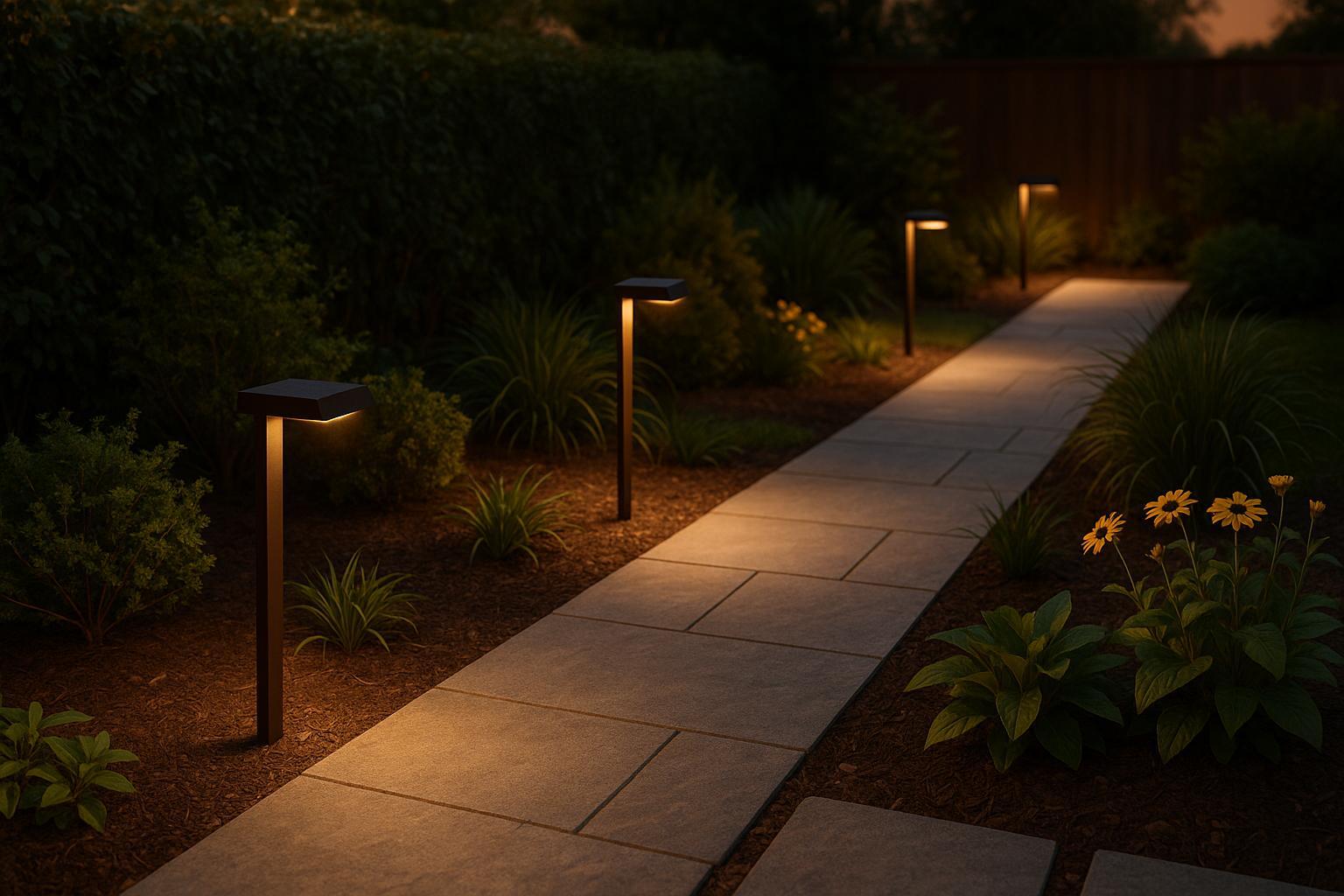
Checklist for Weatherproof Low Voltage Lighting Installation
Learn how to effectively install and maintain weatherproof low voltage lighting for your outdoor space with this comprehensive guide.
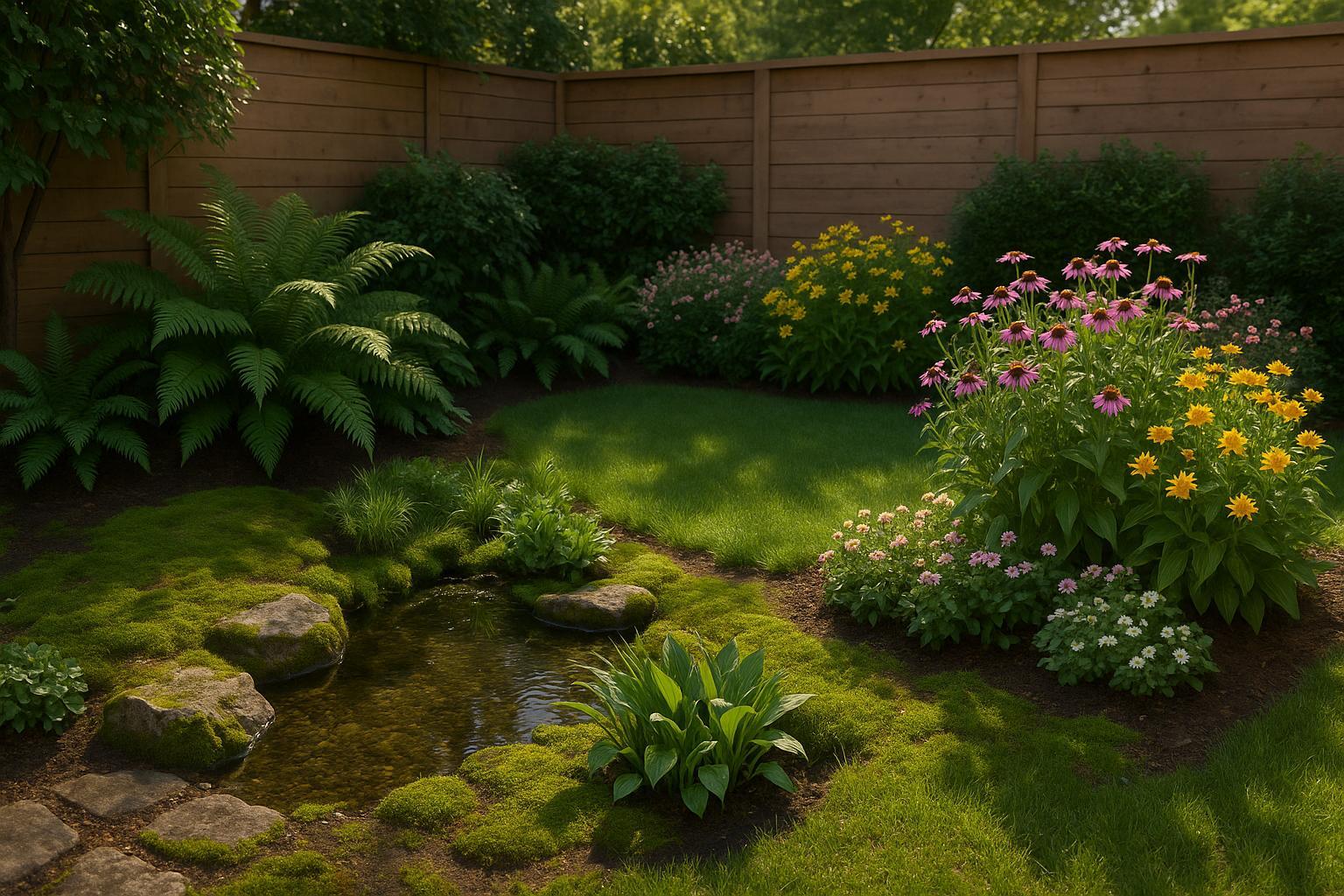
How Microclimates Affect Plant Placement Decisions
Learn how microclimates influence plant growth and discover effective strategies for optimal plant placement in your garden.

Creating a Successful Gardening Plan: A Comprehensive Guide
Learn how to design a successful gardening plan with key elements and seasonal tips. Explore tools and resources for creating and maintaining a flourishing garden.
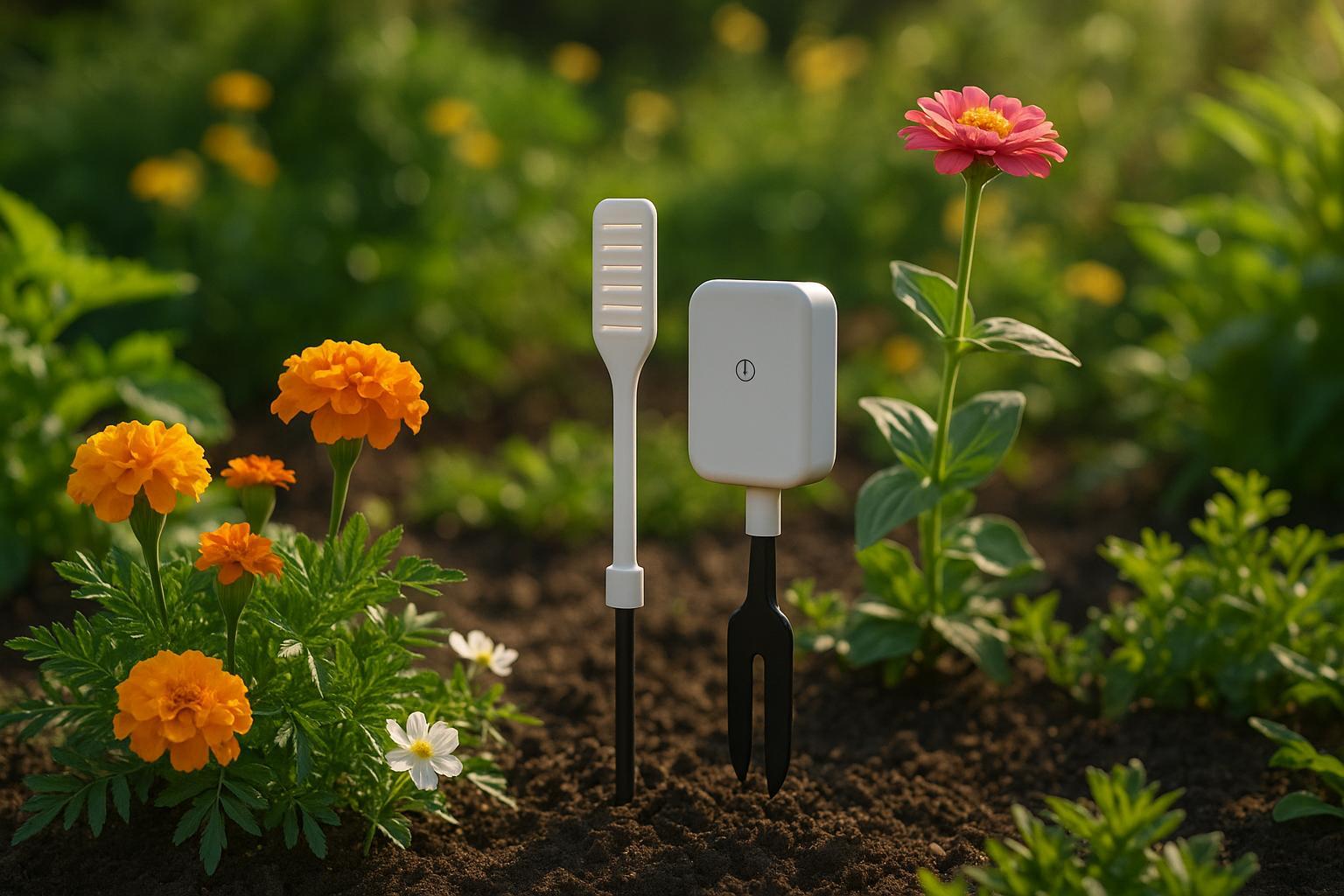
Ultimate Guide to IoT Weather Monitoring for Gardens
Explore how IoT weather monitoring systems enhance gardening through real-time data, automation, and improved resource management.

How to Choose Plants for Your Climate Zone: A Beginner's Guide
Learn how to select plants that thrive in your climate zone by understanding local factors, soil testing, and using AI tools for tailored recommendations.
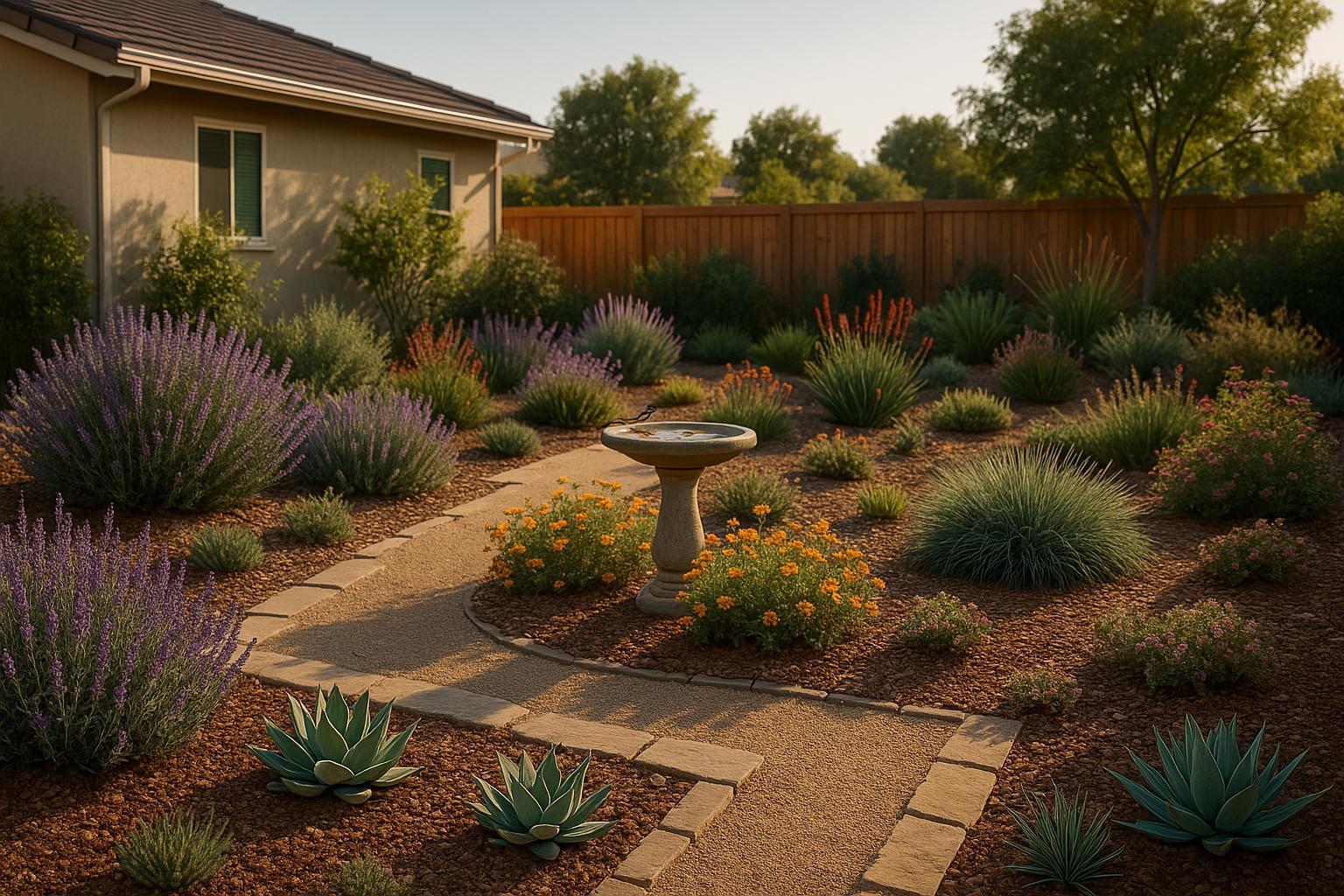
5 Steps to Create a Low-Water Garden
Transform your outdoor space with a low-water garden using simple steps that save money, reduce maintenance, and support ecosystems.